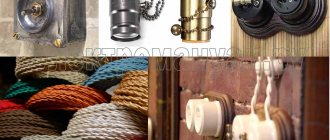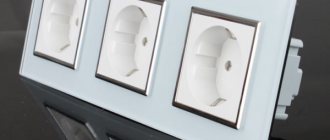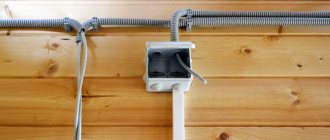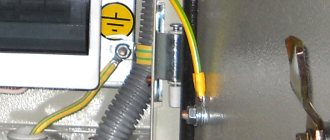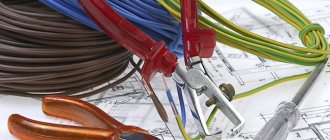1. Open wiring - laid along the surface of walls, ceilings, along trusses and other construction elements of buildings and structures, along supports, etc. . 2. Hidden wiring - laid inside the structural elements of buildings and structures (in walls, floors, foundations, ceilings), as well as along ceilings in floor preparation, directly under a removable floor, etc.
Whether to consider drywall part of the wall or not – opinions vary. And in my opinion, open wiring is one that is easy to access and does not require dismantling structures (walls, ceilings.). And if repairs require breaking plaster or drywall, this is hidden wiring.
Having your own home is a completely different philosophy. Today I arranged the furniture like this, tomorrow I completely swapped the bedroom and kitchen. Yesterday I didn’t have a microwave, today I got a dishwasher. Previously there was one TV, now there are two and each has its own receiver. A computer has appeared, or some other device - you also need power, and other cables.
The bathroom was renovated - an automatic lighting switch with a motion sensor was installed. And so almost every year, all my life. My wiring in the house has probably been changed dozens of times. Everything changes, something new appears, the old is thrown away. New sockets appear and then disappear out of sight. What kind of hidden wiring is there?
Metal hoses are laid in wooden partitions and throughout the attic from switches to ceiling chandeliers. And only where there is no way to hide it, it is forced to be in plain sight in cable ducts.
At any moment, if some new synchrophasotron suddenly appears in the house, there are no problems connecting it to the home network. And even if a rearrangement or redevelopment occurs, it is not difficult to change the wiring. Because it is available.
Questions like “what are the pros and cons”, “which is better” are very common. And there are numerous attempts to create a sort of list of pros and cons. Someone baselessly claims that in one case the aging of insulation occurs faster, someone talks about some kind of protection from accidental damage - believe me, this is all from the evil one. But everyone agrees on one thing: they say, open wiring violates the design.
Open or closed wiring. What explains such a significant difference in the permissible values of current flowing through a cable of the same cross-section for open and closed types of wiring? Types of ele
Combined wiring presupposes the application of the same rules and fastening of the complete set of devices for the construction of electrical wiring. This installation method is used in rare cases and is more complex in terms of implementation.
Expert opinion
It-Technology, Electrical power and electronics specialist
Ask questions to the “Specialist for modernization of energy generation systems”
What is the difference between open and closed wiring? But wiring can be done in a hidden way in the cavities of building structures, above suspended ceiling coverings, in prefabricated partitions, in grooves made in wall coverings, in embedded pipes. Ask, I'm in touch!
Preparatory stage
At the preparatory stage, it is important to make sure that you have all the necessary tools:
- Screwdriver Set;
- grinder, drill, hammer drill or wall chaser;
- nozzles for hammer drills, drills;
- building level;
- hacksaw, knife;
- pliers, wire cutters;
- phase indicator.
TIP: If you don't have the right tools, then don't waste time finding and purchasing them. Call a specialist who will come immediately with all the necessary tools.
The photo shows just one of many tools that will be useful when installing electrical wiring.
The walls must be cleared of foreign objects, which may cause difficulties with marking and installing wires. After this, according to the drawn up diagram, markings begin:
After marking, you need to prepare the walls. If the wiring is hidden, grooves are made along the marked lines, niches are made for sockets, switches, and distribution boxes.
This is what the walls look like after the gating has been done
If the electrical wiring will be installed in an open manner, the walls should be leveled. This is necessary so that the cable channels lie flat and there are no distortions.
Preparatory work
Before carrying out work indoors, you need to pay attention to the line input. Over the past couple of decades, the number and power of household electrical appliances have grown significantly, increasing energy consumption, and the old line may not be able to cope
The second reason is the constant exposure of the cable to sunlight and other external factors outside the home. Metal strands gradually become exposed, which makes the use of electrical wiring less safe.
One of the weak points is the cable entry into the house, which is often routed through the wooden wall of the attic. At one time it was believed that to ensure safety it was enough to place the wire in a rubber hose
It did not take into account that rubber is a conductive material, and as it ages, areas of sparking and local heating may appear
To install a line in a wooden house, you can use one of two methods: underground and aerial.
The first method is quite expensive. It requires excavation work, placing the cable at a depth of about a meter, and marking the security zone with appropriate signs. Thick-walled metal sleeves are installed in places where they pass through the foundation and enter the house. This method is most often used when constructing a new house.
An overhead line will require an electrical wire with a cross-section of 16 millimeters or more. The so-called SIP (self-supporting insulated wire) is often used, the service life of which exceeds 25 years. The connection of the external line to the input line is carried out exclusively outside the building. Installation of cable channels and wiring is carried out after the initial shrinkage of the house and drying of the wood of the walls. Otherwise, the slightest changes in the “geometry” will lead to deformation and destruction of the box.
ELECTRICAL WIRING - TYPES AND TYPES
The word “electrical wiring” is familiar to everyone, but not everyone will correctly explain its meaning. For many, the concept is associated exclusively with wires. In fact, this is a whole system that includes:
And most importantly, this whole system called “electrical wiring in the house” has a specific purpose - to deliver electricity from the power source and distribute it to consumers.
Electrical wiring is carried out in networks with voltages up to 1000 V: in buildings and structures (inside or outside), on the territories of institutions and enterprises, in courtyards and neighborhoods, on construction sites and personal plots.
TYPES AND TYPES OF ELECTRICAL WIRINGS
According to placement, electrical wiring is of two types:
According to the method of installation, both external and internal wiring are also classified into hidden and open.
OPEN ELECTRICAL WIRING
With open wiring, cables and wires are laid along wall surfaces, ceilings and other building elements of the building.
- free suspension;
- directly on the wall surface or ceiling;
- in electrical baseboards;
- on strings;
- in platbands;
- on cables;
- in trays;
- on rollerskates;
- in a flexible metal sleeve;
- on insulators;
- in boxes;
- in the pipes.
In turn, open wiring is divided into three more subtypes:
What kind of lighting do you prefer?
Built-in Chandelier
This is wiring that is permanently connected and cannot be disconnected without the use of a special tool.
The contacts of such wiring are connected to each other using plug connectors (not twisted or soldered), that is, such wiring can be disconnected at any time.
Used to connect mobile mechanisms to the electrical network.
The advantages of open wiring are as follows:
1. It is easy to install. Not even the most experienced electrician, but an ordinary man who understands electricity, can do such electrical wiring in an apartment with his own hands.
2. No additional equipment is required (such as a power tool for cutting grooves).
3. The integrity of ceilings and walls is minimally damaged during installation.
4. The wiring is available at any time for inspection or repair of damage.
5. It is mobile; if you need to move a switch or socket to another location, this can be done without any problems.
Expert opinion
It-Technology, Electrical power and electronics specialist
Ask questions to the “Specialist for modernization of energy generation systems”
Open wiring: the difference between installing external and hidden electrical wiring It turns out that at this stage it is already necessary to have a design project that shows which electrical appliances will be located in the house and where. Ask, I'm in touch!
EXTERNAL ELECTRICAL WIRING
In another way, external electrical wiring is called street wiring. It is laid outside houses, along the walls of structures and buildings, as well as between them on special structures or supports.
Such wiring is necessary to supply voltage to lighting lamps, alarm systems, CCTV cameras and utility rooms (garage, workshop, shed, sauna, bathhouse, swimming pool).
All this must be taken into account at the stage of construction of buildings and structures.
External electrical wiring in a country house is no less important than internal wiring. In addition to the need to provide sufficient lighting in the area, at any time you may need to connect a power tool (drill, grinder, lawn mower, pump) in the yard. Don’t drag the carriers across the entire house and property; when planning the power supply, it is better to mark out places for installing 2-3 sockets.
The most important difference between external electrical wiring is that it is exposed to atmospheric factors - rain, snow, wind, sun rays. Therefore, it must be reliably protected from precipitation, from mechanical influences and accidental human contact with live parts.
General requirements for electrical wiring.
These requirements apply equally to both apartments and private houses:
1. All boxes, sockets and switches must be located in such places that they are always easily accessible.
2. All connections and branches are made only in boxes.
3. It is prohibited to install sockets in wet rooms (bathroom, sauna, bathhouse).
4. Grounding and grounding conductors are connected only by welding.
5. Grounding of stationary plates is carried out by separate conductors.
According to the PUE (Electrical Installation Rules), the following are also regulated:
- standards for the number of sockets per room;
- the distances at which sockets and switches should be placed in relation to the floor and communications;
- norms for laying wires (vertical and horizontal sections).
Open and closed wiring - what's the difference?
- First, be sure to check the wiring diagram and calculations;
- The distance from the floor must be at least 10 cm;
- You cannot make bevels; all wires must be located at right angles;
- The wires must not cross under any circumstances;
- Wires must pass at a distance of at least 10 cm from window frames and doorways;
- The connections must be strong;
- It is strictly prohibited to have uninsulated, exposed wire sections, broken sockets and switches.
- The installation of the electrical panel should be entrusted to a specialist electrician.
Types of wiring
For installation indoors, two types of wiring are used: open and hidden. Each of them has its own advantages and disadvantages and this must be taken into account when choosing.
Open wiring can be stretched anywhere on the wall, since it is covered with special boxes and protective elements for convenience and safety. There is always access to it for repairs or connecting additional elements of the electrical network. However, this type does not look very aesthetically pleasing indoors, and decorating it with wallpaper or cornices is undesirable - this increases the risk of fire. This method is used only if it is not possible to lay the cables using a closed method.
Hammering with a hammer drill
Hidden wiring is hidden in special grooves that are pierced in the walls. Sometimes the nets are placed in boxes and hidden under plaster or other wall finishing. In the future, this type of electrical wiring is difficult to repair, because finding the damaged area is quite problematic; to do this, you need to carefully dismantle the covering and only then carry out repair work
If you have a closed installation, then when drilling into the walls it is important not to damage the cables. This method does not spoil the appearance of the walls during operation, but with each repair you need to be prepared for additional costs to restore the coating
Laying hidden wiring
Often a combined type of installation is used, when important connections are left in plain sight, and the remaining wires are hidden in grooves.
What is open and hidden wiring? How are these installation methods different?
Many people, having planned to renovate their apartment, sooner or later come to the stage of laying electrical wiring. And the first question that arises is: “What is hidden and open wiring? How are these installation methods different? How should the installation be carried out? This article will help with the answer. Below you can find general information regarding hidden and exposed wiring.
Since sockets and switches are used for hidden wiring, similar branched boxes are used for them. Copper and aluminum wires are used to install hidden wiring. The former have a cross-section of about 1 mm2, the latter are used in rubber insulation and their minimum cross-section is 2.5 mm2.
Today, the open installation method is not common. For example, in wooden houses where it is impossible to install electrical wiring in any other way.
Open wiring
Electrical wiring embedded in a stone wall does not pose a particular fire hazard. Of course, an outlet may spark or a faulty electrical appliance may catch fire, but that, as they say, is a completely different story.
In wooden houses, a short circuit or other electrical failure may well cause a fire. Meanwhile, hidden wiring in a country house often becomes the object of attention of rodents. In addition, wood dust accumulates in the voids of wooden houses where wiring is laid, which instantly ignites from a spark. Therefore, in accordance with current Russian standards, electrical wiring on a combustible base is carried out openly.
The advantages of open wiring are obvious. It is easy to install, maintain and control; if necessary, the route can be moved, supplemented or repaired. There are also “cons”. The open installation method eats up part of the space: you cannot hang a shelf on top of the cable, and sometimes you cannot place a cabinet close to the wall.
Reference by topic: Do-it-yourself electrical wiring repair
ELECTRICAL WIRING IN THE HOUSE AND APARTMENT
Apartment wiring is not as expensive in terms of finances, effort and time as wiring in a private home. In multi-storey buildings, each apartment is already connected to an electrical network from the general distribution panel to the input circuit breaker.
Do-it-yourself wiring in apartments is within the capabilities of many and is carried out according to the following approximate plan:
- You should start by drawing up a diagram.
- Based on the diagram, you need to make markings on the walls and calculate the required amount of wire, cable, switching devices and fittings.
- Next comes the installation work - cutting grooves, laying conductors in them, installing boxes, switches and sockets, and connecting all elements.
- The final stage is checking the operation of the assembled circuit.
Electrical wiring in a private house is also quite possible to do with your own hands for a person who understands electricity. Just keep in mind that it differs from the apartment option, since it has additional requirements.
Power supply should be supplied from a 220 V or 380 V network, with a TN-CS grounding system. It is prohibited to lay conductors along heated surfaces, as well as near a stove, chimney or fireplace (this rule is especially true for saunas and baths).
Particularly difficult when laying wiring with your own hands in a private house is the installation of the input. First you will have to go around several institutions to obtain permission and technical conditions.
There is a lot of work to be done on assembling the distribution panel and laying the input line (digging a trench for the cable or installing a tap from an overhead power line). And only then can you proceed with the internal electrical wiring according to the same plan as described above for the apartment option.
If you are not sure that you can install reliable and high-quality electricity. wiring in an apartment or private house yourself in accordance with the requirements of the PUE, it is better to invite a specialist. Remember that 65% of all electrical fires occur in the home electrical system.
© 2014-2022 All rights reserved. The materials on the site are for informational purposes only and cannot be used as guidelines or normative documents.
Features of closed wiring
Closed wiring is installed almost identically to open wiring. The same cables marked VVG are suitable for both types.
Hidden wiring is carried out before the final wall covering. The wires are hidden in a metal pipe; the use of plastic is strictly prohibited. If it is necessary to make a turn, use a curved pipe. As an option - a regular one, and another one is welded to it.
Before final covering of walls and pipes, it is necessary to organize the output of all necessary cables to the outside. In predetermined places, holes are prepared for switches, sockets and distribution boxes. A separate hole is required for the distribution board.
Surface-mounted switches and sockets are attached to the wiring
When drilling holes for branch boxes and sockets, you can use wood drill bits. The main requirement is to be careful, otherwise you may damage the cable.
The opening for the distribution board depends on its type. If it is overhead, the holes have an arbitrary shape, the edges are hidden under the protective material. When installing a built-in panel, the hole in the paneling must correspond to its size and shape, taking into account that the side will hide the edge.
After covering the walls and preparing the required holes, all boxes and sockets are installed. In most cases, overhead devices are used: drilling all the holes in a solid wooden wall is dangerous from a fire safety point of view.
Following the rules of technology and safety precautions will allow you to independently install electrical wiring in a wooden house
In such buildings it is especially important to comply with fire safety rules.
Hidden wiring
Sometimes you can hear the expression internal wiring. But it should be said more precisely and correctly - hidden electrical wiring. With this method, all conductors are walled up in the walls or ceiling. They can be hidden either behind a layer of plaster or behind plasterboard panels. Only sockets and switches, as well as lamp sockets and junction boxes remain visible.
The safety of such wiring is quite high. Both in terms of fires and the inability to touch live parts. Moreover, the service life is much longer than that of an open analogue. In addition, it does not spoil the appearance.
But installing hidden wiring is quite labor-intensive. In addition, without an accurate wire layout, the possibility of repairing the line is reduced to almost zero. You will also definitely need a plan when you need to make a hole in the wall. Otherwise, you may get caught in the cable and receive an electric shock.
What's the difference?
4. Hidden wiring elements are not exposed to solar or mechanical influence, thereby increasing their service life.
Expert opinion
It-Technology, Electrical power and electronics specialist
Ask questions to the “Specialist for modernization of energy generation systems”
ELECTRICAL WIRING - TYPES AND TYPES
HIDDEN ELECTRICAL WIRING
Hidden electrical wiring is laid inside the structural elements of the building - in floors and foundations, in wall surfaces, under removable floors. There are several ways to lay a cable or wire:
- in pipes;
- in furrows under plaster;
- in a flexible metal sleeve;
- in the voids of a building structure;
- in the channels;
- in boxes;
- in niches of plasterboard structures.
Nowadays it is rare, but in Soviet times such a method as embedding conductors into a building structure during its manufacture was often used.
Advantages of hidden wiring:
1. It is not visible, does not spoil the interior of the room and does not interfere with any finishing work.
2. This installation method is characterized by a high level of electrical safety. All conductors are hidden, which means touching live parts and electric shock are minimized.
3. Being under a layer of plaster, hidden wiring does not have air access, as a result of which it has high fire safety.
4. Hidden wiring elements are not exposed to solar or mechanical influence, thereby increasing their service life.
Disadvantages of the hidden method of laying electrical wiring. postings:
1. It is practically impossible to repair such wiring. If a wire burns out somewhere, finding the location of the damage will be very problematic.
2. Labor-intensive installation.
3. It is necessary to immediately clearly think through the locations of sockets and switches, and the routes for laying wires, since it will be difficult to change anything in the future.
4. It will be necessary to draw up an exact wiring diagram. After all, when you need to drill a hole to attach a picture or shelves, you need to be sure that you won’t hit the wire with the drill. You can, of course, do without a circuit, but then you will have to buy a special device to detect hidden wiring.
Tools for work
- Wires or sockets should not be closer than 50 cm to metal pipes, gas stoves and any heating appliances.
- The wire in a horizontal plane should be located at a distance of no closer than 1-1.5 meters from the ceiling or floor.
- There must be at least one meter from corners, window and door openings to wiring running in a vertical plane.
- Connection of conductors is possible only in junction boxes.
- The cable cores are either welded (soldered) to each other or crimped.
- All sockets, switches, and boxes should be located in convenient places for easy access.
- For bathrooms, the installation of one socket with additional insulation is allowed.
- It is always necessary to use a device for feeding cables into the wall in the form of a piece of hollow pipe when you need to route the wiring to another room.
Wall work
When the markings on the wall are ready, you can begin another stage of work, which is also no less important. However, before you start drilling or gouging out the wall, you need to decide how the wires will be installed on the wall, open or closed.
So, for the closed method it is typical to trench the walls, i.e. make special grooves in the walls where the wires will be laid, after which these channels are sealed with plaster.
But for the open method, such actions will not have to be performed; the wires will be hidden in special boxes for electrical wiring.
Conclusions and useful video on the topic
We have selected useful video materials that will help you avoid common installation mistakes and correctly organize external electrical wiring in your home.
Instructions for installing electrical wiring in a cable channel:
The main mistakes made when connecting an RCD:
In theory, the technology for arranging open wiring looks simple and understandable. But when it comes to practice, many home owners make a lot of mistakes.
Only undertake DIY installation if you have the necessary knowledge to develop and implement the project. If not, then do not risk your life and entrust this work to electricians.
Are you well versed in the theory of open wiring installation and have practical experience in performing electrical work? Maybe you would like to supplement the material we have presented with clarifications or useful recommendations? Write comments in the block below the article, share your experience with beginners - many users will be grateful to you.
Electrical wiring refers to all electrical wires and cables installed in a house or apartment. They are designed to supply electricity to household and lighting appliances. Today we are nowhere without technology, so let's take a closer look at all these cables and junction boxes.
Open wiring – retro + progress
Traditionally, open wiring was done with stranded wire on ceramic insulators. This is the way today. most suitable for retro style, easy to replicate using modern twisted three-core or two-core wire and ceramic holders. Styling will cost more than exposed wiring from a regular cable on plastic or metal brackets. But in any case, the distance between the holders should be no more than 50 cm, and in difficult areas they are placed more often.
To protect exposed wiring from a regular cable from accidental damage, cable ducts and plastic skirting boards are used. Their internal space may have partitions that allow both low-current and power cables to be laid inside the boxes at the same time. The removable upper part provides the ability to monitor the condition of the route and its modernization.
✓Note
The protective ground in the three-core cable must be connected to a galvanized steel ground loop buried in the ground near the house. The lightning protection system is also connected to the grounding loop. In general, this is a separate independent project that takes into account the properties of the soil, the occurrence of groundwater, and the meteorological features of the region.
Electrical wiring begins with a project
The power supply of a country house should be carried out according to a project carried out in a specialized organization that has official permission and approved by the Rosenergonadzor authorities. But before ordering a project, you need to draw up technical specifications. To do this, you will need to obtain information about the power allocated to an apartment or house (a certificate is issued by the operating company), draw a diagram of the location of sockets, switches and lighting fixtures (or order a design project), and also count the expected consumers of electricity. The power supply system installed according to the project is tested, after which it is accepted into operation by an Energonadzor inspector. Only this approach guarantees the electrical and fire safety of the house. In practice, an electrical project is often carried out by an architect-developer of the general construction part, or even a designer, who does not have not only the appropriate permits, but also the proper knowledge.
Open and closed electrical wiring
Electrical wiring installed in a home can be open or closed . If we talk about open wiring, it is performed as follows.
Open wiring
Closed wiring
But wiring can be done in a hidden way - in the cavities of building structures , above suspended ceiling coverings, in prefabricated partitions, in grooves made in wall coverings, in embedded pipes. Horizontal places for power cable distribution are laid in the floor covering, which is made of non-combustible materials, such as “warm floors”.
Processes of laying wiring under the plaster layer, in partitions, in cavities of building structures
Expert opinion
It-Technology, Electrical power and electronics specialist
Ask questions to the “Specialist for modernization of energy generation systems”
Closed electrical wiring Knowing the drawing, you can independently draw up a diagram with your own hands and connect the devices, without having to resort to the help of professionals. Ask, I'm in touch!
Open wiring
Open wiring is a way of conducting an electrical network in an apartment or house without covering the wires themselves with anything. Usually this is stretched along the walls. It is bent to the shape of the corners, sometimes stretched closer to the floor.
This option is extremely cheap to implement - you will only have to spend money on wires and holders, and, in theory, on labor, provided that the owner is not able to carry out such a repair procedure on his own. This is done quite simply. Any future repair work will also be easier.
There are a number of significant disadvantages due to which it is usually abandoned. Disadvantages include:
- The possibility of accidentally damaging wires in everyday life, because... they are not protected at all.
- Violation of the aesthetic appearance of the room, which does not please designers or even ordinary attentive housewives.
- Increased fire hazard of the premises, all for the same reason of complete unprotection and exposure of the common bundle of electrical wires.
The open type is usually not used in residential premises, but it is actively used in places of temporary stay.
Example diagram for a private house
In 95% of cases, air “communication” is used.
As for meters, today energy supply organizations install them in the incoming electrical panel on the street (a few years ago, installation of metering devices took place inside a private house). In addition to the meter, a switch is sometimes mounted in the switchboard.
The cable is laid from the input panel to the internal one. The supply of electricity to the building begins from the electrical panel installed inside. To add network reliability, professionals recommend dividing power consumers into groups:
Consumers need to be separated in order to connect and install individual protective devices. This is what the scheme for dividing devices into groups looks like:
A mandatory requirement for drawing up a diagram is the availability of a plan for a private house. Knowing the drawing, you can independently draw up a circuit with your own hands and connect the devices, without having to resort to the help of professionals. For example, we took a simple diagram:
Having the above material in hand, you can begin to draw up a schematic diagram. This is more difficult, since it requires electrical knowledge. If it is not possible to draw up a diagram yourself, then it is better to ask a friend about it or, as a last resort, hire an electrician.
Features of 3-phase power
If your private home is supplied with 3-phase power, and not 1-phase, then the combined and working wiring, as well as three phases, are connected from the air support to the input panel. There are not many differences in the circuit for 3-phase power supply:
Wiring Requirements
Wood is the most popular material used in the construction of private housing. Despite its advantages, wood is a fire hazardous and flammable material.
Basic requirements for electrical wiring in wooden buildings:
- Safety - Wiring must be routed in such a way as to minimize the likelihood of overheating and ignition of the cable, as well as to prevent the transmission of open flames to adjacent wooden structures.
- Design - the technical characteristics and performance of the wires and components used must correspond to the calculated peak load on a specific section of the electrical network. To prevent heating, the cable cross-section is selected with a margin of 20–30%.
- Laying method - it is preferable to carry out the electrification of wooden buildings using the open method. This allows you to easily and regularly diagnose the state of the electrical network.
- Insulation - the location of the input unit (electrical panel) must be isolated from interface with wooden structures. It is ideal if the electrical panel is installed in a room with a partition made of non-combustible materials.
- Conductor - it is better to use a three-core copper cable with insulation made of non-combustible materials as a conductor. Laying the cable in PVC corrugation is strictly prohibited.
- Automation - a circuit breaker must be installed for each group in the electrical network. The current rating of the circuit breaker is selected in accordance with the load on the site. It is highly not recommended to overestimate the current rating, as this will lead to overheating of the conductor.
It is not recommended to independently lay a power cable and install an electrical network without appropriate experience - this should be done by specialists. But every owner of a private home must know the basic rules of electrification. This will allow him to diagnose existing wiring, and will also provide an opportunity to control the quality of work of hired electricians.
Regulations
Electrical Installation Rules is the main document for electrical wiring design
General requirements and rules for electrical wiring are described in the following documents:
- PUE, edition 7 - the main document used in the design of the electrical network. It describes in detail the choice of conductor, switchgear, automation and lighting.
- SNiP 3.05–06–85 - electrical wiring in old and new houses. Methods of wiring and rules for introducing power cables into residential premises.
- SNiP 31–02 - requirements for the installation of power supply systems in residential buildings. The document complies with the norms and rules described in the PUE.
The information contained in these sources is described in technical language and may not be understandable to an unqualified person. When studying on your own, we recommend relying on the “Rules for Electrical Installations”, since this document most clearly formulates the meanings and concepts necessary for installing wiring in private homes.
Preparation
Before you pick up a tool, you need to carefully calculate everything and draw up a plan diagram. Switches are located near doorways. If the wiring runs in unheated or damp rooms, then you need to use wires in a special sheath, or put them in metal pipes.
The cable must be laid strictly vertically or horizontally. On turns and bends it should pass at 90 degrees. If it intersects with metal parts, it is necessary to strengthen the insulation. You can strengthen the insulation by simply winding several turns of electrical tape at the point of contact with the metal.
We punch grooves (grooves) using a wall chaser, a hammer drill, or, in the absence of either, simply with a chisel and a hammer. If the walls are wooden, then sheet asbestos is placed under the wire.
There are two ways to bring electricity to an Ilyich light bulb or a modern LED - using hidden or open wiring. Each of these methods has its own disadvantages, and they are not without advantages. We will sort out their pros and cons, and see which wiring is better for different rooms, which will help the owner of the apartment to loudly say “let there be light.”
It would be more correct to pose the question not “which wiring in the apartment is better,” but which is more rational, but this does not change the essence. To the point.
Expert opinion
It-Technology, Electrical power and electronics specialist
Ask questions to the “Specialist for modernization of energy generation systems”
External wiring with an open wire In just a couple of days, without much experience, you can independently handle the installation of open wiring in an apartment with one living room. Ask, I'm in touch!
Installation
After marking and cutting the grooves, the cables are laid in them. All connections are made in installation boxes using special plugs. You can, of course, solder the wires, but this is completely unnecessary and takes a lot of time. The plug connection is fast and reliable, the main thing is to choose original materials.
When connecting switches, you need to open the phase, not the zero. The phase comes to the bottom of the socket, and not to the side, so that you do not accidentally catch it when replacing the light bulb. These are the basic rules on how to do the wiring in the house with your own hands - remember them and follow them without fail.
After the wires are laid out, you need to connect them to the electrical panel, installing automatic circuit breakers, an RCD, and a meter in it. It can only be moved or sealed by an employee of the energy supply company, so do not rush to remove it yourself - you will be fined a large amount. It is advisable to label all cables entering the meter, stick stickers on the machines indicating what they are responsible for, or sign them with a marker. It is also advisable to stick a connection diagram on the panel door, otherwise in 5-10 years you simply will not remember what was assembled and how.
Hidden wiring
Hidden wiring is a classic in the home electrification genre. It’s not worth talking about this method for a long time, since it is well known to everyone since the age of 10, but briefly you can describe it like this:
- — A groove is made in the wall or ceiling,
- — The cable can also run through the voids of floors without gating,
- — The gate goes from the distribution box to the end point (switch, socket),
- — A wire is laid in the channel,
- — The wire is fixed with gypsum plaster,
- — The ends of the wire are connected to the box and the socket or switch.
Hidden wiring is always started before finishing begins; the grooves are sealed with a gypsum mixture and then puttyed, painted, or other executions are performed on the walls and ceiling. If necessary, you can later find such wiring using a detector, so it is not necessary to draw exact network plans.
Useful tips Connection diagrams Principles of operation of devices Main concepts Meters from Energomer Precautions Incandescent lamps Video instructions for the master Testing with a multimeter
Hidden or exposed wiring?
Before developing an electrical project and installing it, you need to decide on the type of future wiring. It comes in two types: open and hidden. Let's look at the features, pros and cons of each of them.
Open wiring consists of insulated wires laid along the surface of the walls. Wiring is fastened to the walls using cable ducts or metal brackets.
Advantages of open wiring:
Disadvantages of open wiring:
- unaesthetic appearance. Open wiring does not always fit into the design of the room;
- bulkiness. Open wires “eat up” free space and do not allow interior items to be placed where they lie; sockets and switches protrude greatly above the wall surface.
Hidden wiring is insulated wires laid in grooves. This wiring is stationary, so the location of the wires, as well as the connection points of the devices, must be determined before installation.
Advantages of hidden wiring:
- compactness. The wiring does not take up useful space in the room and does not interfere with the free arrangement of furniture;
- aesthetics. Wires do not disturb the appearance of the room, switches and sockets are located almost in the same plane with the wall;
Disadvantages of hidden wiring:
- inability to assess the condition of the wires. Any wiring gets older and wears out over time, and this can reduce the quality of electricity and create the risk of short circuits and fires. It is not possible to assess the condition of hidden wiring without a special tool;
- inability to assess the location of the wires. If a person bought a house, apartment or office with hidden wiring, he cannot independently determine where the wires are located and risks touching them during repair work;
- stationary character. If the owners of a room with hidden wiring want to change the location of certain household appliances, sockets and switches, they will have to hollow out the walls and build up wires, which is time-consuming, labor-intensive and quite expensive.
Distribution boxes
To organize the electrical network of a house or apartment, distribution boxes, or, as they are also called, distribution boxes, are used. They are installed at junctions, or, if you like, branches of individual electrical wiring cables. There are such boxes in every room. They are usually located under the ceiling. There are two types of distribution boxes: for hidden and outdoor installation.
Hidden distribution boxes are recessed into special sockets under the ceiling, at the convergence of several cable channels. The main power cable comes into the box, and from it branch cables for powering sockets, a cable for a switch, cables for powering lighting devices: chandeliers, sconces, spotlight sections, etc. Open boxes are mounted directly on the wall in the most convenient place for this. .



